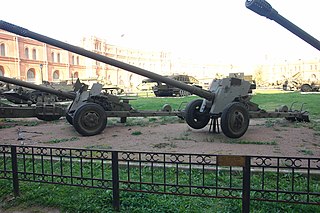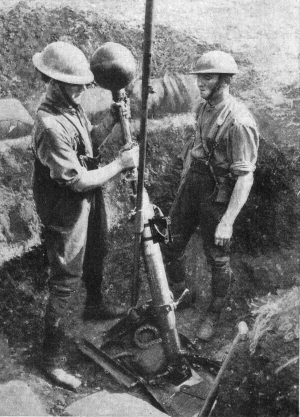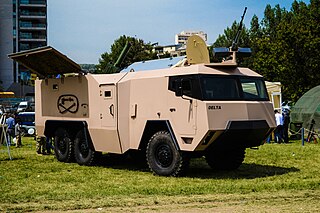
The M224 60 mm Lightweight Company Mortar System (LWCMS) is a smooth bore, muzzle-loading, high-angle-of-fire mortar used for close-in support of ground troops. It was deployed extensively in the War in Afghanistan by the United States military.

The M252 81 mm medium weight mortar is a British-designed smooth bore, muzzle-loading, high-angle-of-fire weapon used for long-range indirect fire support to light infantry, air assault, and airborne units across the entire front of a battalion zone of influence. In the U.S. Army and U.S. Marine Corps, it is normally deployed in the mortar platoon of an infantry battalion.
The Mauser MG 213 was a 20 mm aircraft-mounted revolver cannon developed for the Luftwaffe during World War II. It was never put into service, but the principles formed the basis for several post-war developments by the Allies. A 30 mm version was developed as the MG 213C or MK 213 and it was this that led to the British ADEN, French DEFA and American M39 cannon.

2A19 or T-12 is a Soviet-designed 100-mm anti-tank gun. It was the first anti-tank gun to adopt a smoothbore barrel, and to introduce modern armor piercing shot, like the APFSDS. It uses long projectiles that are more powerful than its caliber suggests. The T-12 served as the primary towed anti-tank artillery in the Soviet and Bulgarian armies from the early 1960s to the late 1980s.

The M1 mortar is an American 81 millimeter caliber mortar. It was based on the French Brandt mortar. The M1 mortar was used from before World War II until the 1950s when it was replaced by the lighter and longer ranged M29 mortar.

The Ordnance SBML two-inch mortar, or more commonly, just "two-inch mortar", was a British mortar issued to the British Army and the Commonwealth armies, that saw use during the Second World War and later.

The M2 Mortar is a 60 millimeter smoothbore, muzzle-loading, high-angle-of-fire weapon used by U.S. forces in World War II, the Korean War, and the Vietnam War for light infantry support.
The L9A1 51 mm light mortar was a man-portable platoon-level mortar used by the British Army from 1988 to 2007.

The 2S4 Tyulpan is a Soviet 240 mm self-propelled heavy mortar. "2S4" is its GRAU designation. The Tyulpan is the largest mortar system in use today.

The 2 inch medium trench mortar, also known as the 2-inch howitzer, and nicknamed the "toffee apple" or "plum pudding" mortar, was a British smooth bore muzzle loading (SBML) medium trench mortar in use in World War I from mid-1915 to mid-1917. The designation "2-inch" refers to the mortar barrel, into which only the 22-inch bomb shaft but not the bomb itself was inserted; the spherical bomb itself was actually 9 inches (230 mm) in diameter and weighed 42 lb (19 kg), hence this weapon is more comparable to a standard mortar of approximately 5-6 inch bore.

The term Commando mortar refers to a class of lightweight infantry mortars designed for maximum portability and rapid deployment with a caliber of 60mm or less in diameter, at the expense of accuracy and repeatability. Earliest models had been introduced from the 1930s onwards.

The Royal Ordnance L11A5, officially designated Gun 120 mm Tk L11, is a 120 mm L/55 rifled tank gun design. It was the first of NATO's 120 mm main battle tank guns which became the standard calibre for Western tanks in the later period of the Cold War. A total of 3,012 of the L11 guns were produced by 2005. The list price was US$227,000 in 1990.

The M6 Mortar is a 60 mm lightweight infantry mortar made by Hirtenberger AG of Austria.

The Hirtenberger M6C-210 is a light mortar with smoothbore barrel, part of the M6 mortar range designed by Hirtenberger Defense Systems of Austria.
Esperanza y Cia, SA (Ecia) was a defense equipment manufacturer based in the city of Markina-Xemein in province of Vizcaya, Basque Country, Spain. From its origins, Ecia had focused primarily on the design and manufacture of mortars and their ammunition.

The Didgori-II is an armoured multi-role and special operations vehicle produced by STC Delta. It was developed in 2009 alongside the Didgori-1 using the same internal features with some additional functions. The armoured personnel carrier is thought to provide transport, enhanced visibility and firepower support for infantry troops and Special Forces in various missions including reconnaissance and convoy protection.

The Type 2 12 cm mortar is a smooth bore, muzzle-loading type mortar which, except for the firing mechanism, closely resembles the conventional Stokes-Brandt 81 mm mortar. The bipod and cradle of the two types of mortars are identical, except for size and the fact that the bipod legs can be removed as a unit from the cradle of the 120 mm mortar. The large, ribbed base plate has only one socket for the spherical projection on the barrel. A Type 2 120 mm mortar was reported captured at Leyte. The Type 2 120 mm mortar was considered an effective mortar by the Imperial Japanese Army; however, its production only commenced during the latter half of WWII, and its overall service action was limited.

The State Military Scientific-Technical Center "DELTA" is a legal entity of public law established by the decree of the President of Georgia. Its full name is Legal Entity of Public Law - State Military Scientific-Technical Center "DELTA". The scope of work of the organization is mainly focused on the Defense Industry and to some extent on the Civilian Field. The Center is an organization separate from state governing bodies. Its state control is exercised by the Ministry of Defense of Georgia The mission of the organization is based on the state interests of Georgia and the national defense strategy. The Center's primary responsibility is to encourage the growth of the domestic military industry. introduction of cutting-edge military technologies in the design, development, and mass production of combat gear and weapons that are in line with global trends. The only company in Georgia involved in the defense industry is State Military Scientific-Technical Center Delta. Today, “DELTA” has both intellectual and technical resources to design and manufacture both military and civilian products.

The GMM-120 self-propelled mortar is a proposed armoured mortar carrier concept with a 120 mm automated mortar station. The system is being developed by STC Delta.
The 60mm HVMS gun is a self-loading autocannon jointly developed by OTO Melara of Italy and the Israel Military Industries (IMI). It was designed to be mounted on light armoured vehicles to provide an anti-armour capability using high-velocity sub-calibre kinetic ammunition.

















